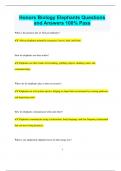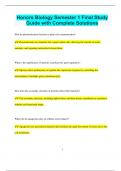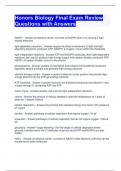Honors bio - Study guides, Class notes & Summaries
Looking for the best study guides, study notes and summaries about Honors bio? On this page you'll find 272 study documents about Honors bio.
Page 3 out of 272 results
Sort by

-
Honors Biology – Plants Questions and Answers Graded A+
- Exam (elaborations) • 12 pages • 2024
- Available in package deal
-
- $9.99
- + learn more
Honors Biology – Plants Questions and Answers Graded A+ What is the primary function of roots in plants? Roots anchor the plant and absorb water and nutrients from the soil. What is the role of chlorophyll in photosynthesis? Chlorophyll absorbs light energy, which is used to convert carbon dioxide and water into glucose. How do stomata regulate gas exchange in plants? Stomata open and close to allow the exchange of oxygen, carbon dioxide, and water vapor between the plant a...

-
Honors Biology Elephants Questions and Answers 100% Pass
- Exam (elaborations) • 12 pages • 2024
- Available in package deal
-
- $9.99
- + learn more
Honors Biology Elephants Questions and Answers 100% Pass What is the primary diet of African elephants? African elephants primarily eat grasses, leaves, bark, and fruits. How do elephants use their trunks? Elephants use their trunks for breathing, grabbing objects, drinking water, and communicating. What role do elephants play in their ecosystem? Elephants act as keystone species, helping to shape their environment by creating pathways and dispersing seeds. How do elephant...

-
Honors Biology Semester 1 Final Study Guide with Complete Solutions
- Exam (elaborations) • 15 pages • 2024
- Available in package deal
-
- $9.99
- + learn more
Honors Biology Semester 1 Final Study Guide with Complete Solutions How do plasmodesmata function in plant cell communication? Plasmodesmata are channels that connect plant cells, allowing the transfer of water, nutrients, and signaling molecules between them. What is the significance of operons in prokaryotic gene regulation? Operons allow prokaryotes to regulate the expression of genes by controlling the transcription of multiple genes simultaneously. How does the secondary str...

-
Honors Biology - Unit 2 Questions with Verified Solutions
- Exam (elaborations) • 13 pages • 2024
- Available in package deal
-
- $9.99
- + learn more
Honors Biology - Unit 2 Questions with Verified Solutions What is the term for the process by which cells take in large particles, such as food or pathogens, through engulfing? Phagocytosis What is the name of the fluid mosaic model that describes the arrangement and movement of proteins within the phospholipid bilayer of cell membranes? Fluid Mosaic Model What is the term for the cellular structure responsible for packaging and modifying proteins and lipids before they are se...

-
Honors Biology Basics Questions and Answers Already Passed
- Exam (elaborations) • 12 pages • 2024
- Available in package deal
-
- $9.99
- + learn more
Honors Biology Basics Questions and Answers Already Passed What is the term for the chemical process where cells break down glucose to produce energy, without using oxygen? Anaerobic Respiration What is the name of the cell structure that contains enzymes to digest and recycle cellular waste? Lysosome What is the term for the process by which a cell membrane engulfs extracellular material to form a vesicle? Endocytosis What is the name of the pigment found in plant cells...

-
Honors Biology Final Exam Review Solved Correctly Questions With Solutions.
- Exam (elaborations) • 20 pages • 2024
- Available in package deal
-
- $8.39
- + learn more
autotroph - Answer-organism that can capture energy from sunlight or chemicals and use it to produce its own food from inorganic compounds; also called a producer biosphere - Answer-part of Earth in which life exists including land, water, and air or atmosphere community - Answer-assemblage of different populations that live together in a defined area consumer - Answer-organism that relies on other organisms for its energy and food supply; also called a heterotroph ecology - Answer-scienti...

-
Honors Biology Final Test Questions with Answers
- Exam (elaborations) • 14 pages • 2024
-
- $12.79
- + learn more
Honors Biology Final Test Questions with Answers phalanges - Answer-smallest bones at the finger tips tarsals - Answer-toe bones attached to foot metatarsals - Answer-toe bones attached to tarsals phalanges - Answer-toe bones at the tip of the toes cervical - Answer-top section of spine with 7 vertebrae thoracic - Answer-middle section of spine with 12 vertebrae lumbar - Answer-lower section of spine with 5 vertebrae saccrum - Answer-below spine - 5 fused vertebrae co...

-
Honors Biology Unit 3 Test with Complete Solutions
- Exam (elaborations) • 11 pages • 2024
- Available in package deal
-
- $9.99
- + learn more
Honors Biology Unit 3 Test with Complete Solutions What is the primary role of the Golgi apparatus in the cell? The Golgi apparatus modifies, sorts, and packages proteins and lipids for transport to various destinations inside or outside the cell. How does passive transport differ from active transport? Passive transport moves substances across the cell membrane without energy input, while active transport requires energy to move substances against their concentration gradient. ...

-
Honors Biology Final Exam Review Questions with Answers
- Exam (elaborations) • 16 pages • 2024
-
- $13.29
- + learn more
Honors Biology Final Exam Review Questions with Answers NADP+ - Answer-an electron carrier; converts to NADPH when it is carrying 2 high energy-electrons light-dependent reactions - Answer-require the direct involvement of light and light-absorbing pigments; produces ATP, NADPH, & oxygen; occurs within the thylakoids light-independent reactions - Answer-ATP and NADPH molecules (from light-dependent reactions) are used to produce high-energy sugars from carbon dioxide; produced ADP, NADP+...

-
Honors Biology Unit 7 with Certified Solutions
- Exam (elaborations) • 10 pages • 2024
- Available in package deal
-
- $9.99
- + learn more
Honors Biology Unit 7 with Certified Solutions What is the function of the lymphatic system in immunity? The lymphatic system helps to transport lymph, a fluid containing immune cells, throughout the body to fight infections. How do B cells contribute to the immune response? B cells produce antibodies that bind to specific antigens, marking them for destruction by other immune cells. What are the primary components of the innate immune system? The primary components of the in...

Did you know that on average a seller on Stuvia earns $82 per month selling study resources? Hmm, hint, hint. Discover all about earning on Stuvia


